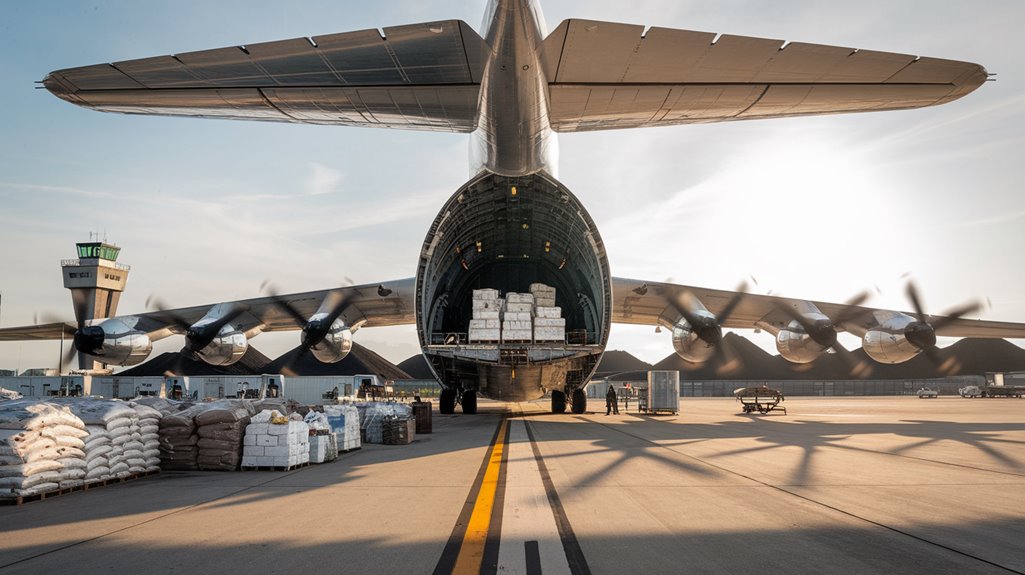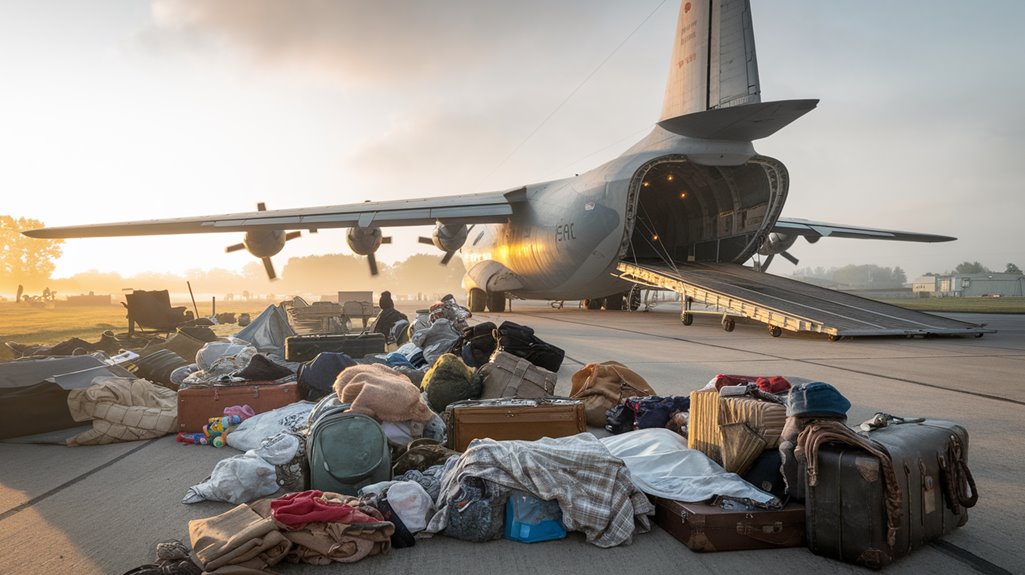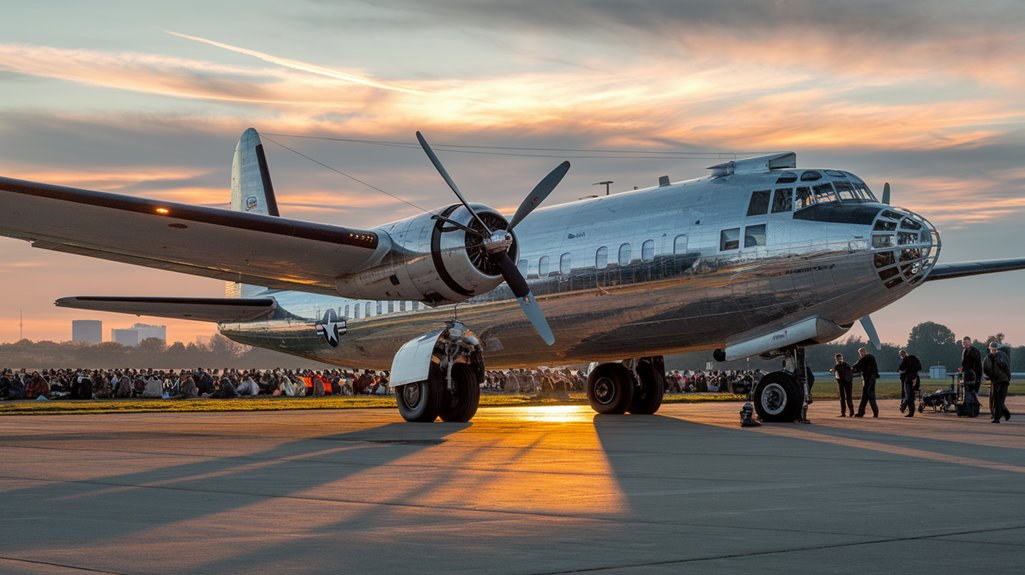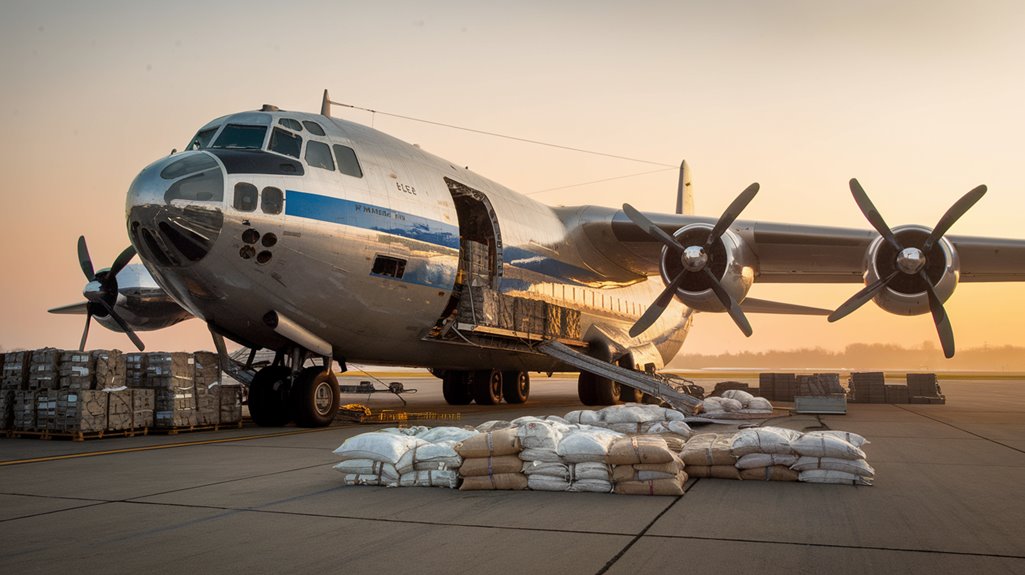Packing 1,000 People Onto One WWII Plane: The Greatest Airlift
You might be surprised to learn that a single WWII aircraft once carried 1,000 people to safety during the Berlin Airlift – a feat that defies modern aviation standards. While today's commercial planes typically hold 200-300 passengers, this remarkable mission pushed the boundaries of what anyone thought possible. As Soviet forces tightened their grip on Berlin in 1948, Allied pilots didn't just break records; they rewrote the rules of humanitarian aid. The full story reveals even more astounding details about this historic operation.
The Soviet Challenge: Berlin Under Siege

While post-war Europe struggled to rebuild, the Soviet Union launched an aggressive campaign to control Berlin on March 25, 1948. Their Soviet Strategy was clear: force the Western allies out of Berlin by cutting off all ground access to the city.
You'd have witnessed a city quickly running out of essential supplies as the Berlin Blockade intensified. When the Soviets introduced restrictions on Western traffic, they weren't just blocking roads – they were severing rail lines, waterways, and even electricity. The Western allies had approximately 36 days of food stockpiled when the blockade began. The crisis escalated when Soviet forces withdrew from the Allied Control Council in protest of Western policies.
By June 24, the blockade had completely isolated West Berlin from the outside world.
What sparked this crisis? The Soviets were responding to the West's introduction of the Deutsche Mark and plans for a unified Western German state. They'd calculated that choking Berlin would prevent Western economic influence from spreading through post-war Europe.
Operation Planning: From Crisis to Action
As Soviet blockades tightened their grip on Berlin, Allied forces launched Operation Vittles on June 26, 1948, with just 32 C-47 aircraft carrying 80 tons of essential supplies.
You'll find it remarkable that what started as a three-week crisis management plan evolved into a massive logistical operation.
Initial projections estimated that 600-700 tons of daily supplies would sustain West Berlin through dried foods, but reality demanded far more.
Under Brigadier General Joseph Smith's command, the operation quickly adapted its logistical strategies. Like many successful case study narratives, the Berlin Airlift demonstrated how critical adaptation and problem-solving were to mission success.
They switched from C-47s to more efficient C-54s, which could handle larger loads with faster unloading times.
The implementation of instrument flight rules and coordinated scheduling maximized aircraft usage, while ground-controlled radar systems at Tempelhof and RAF Fassberg enhanced operational efficiency in all weather conditions.
The team created detailed how-to guides for pilots to standardize procedures and maximize efficiency during the complex operation.
Breaking Records: Daily Flight Statistics
The operational scale of World War II airlifts shattered expectations and set remarkable records.
During these missions, the Me 323 Gigant aircraft played a crucial role in German transport operations.
You'd be amazed to learn that on August 1, 1945, pilots achieved an astounding 1,118 round-trip sorties, demonstrating record-breaking efficiency by averaging two flights per aircraft. One C-54 even completed three round trips in just 22.25 hours.
The cargo tonnage reached unprecedented levels, with crews delivering 5,327 tons in a single day without any fatalities. Allied pilots flew these dangerous missions over the Eastern Himalayan Uplift while battling extreme weather conditions.
By July 1945, the operation had expanded to include 662 aircraft, maintaining an impressive 85% availability rate.
You'll find it remarkable that the monthly tonnage peaked at 71,042 tons that same month.
The safety improvements were equally notable, with the major accident rate dropping to just 0.18 aircraft per 1,000 flight hours.
Behind the Scenes: Maintenance and Logistics
Behind every successful wartime airlift stood an intricate network of maintenance crews and logistical support that kept the aircraft flying.
You'd be amazed by the maintenance strategies they developed, including a 24/7 schedule with color-coded control boards tracking each plane's status. They divided maintenance into three key functions: preflight checks, turnaround maintenance, and routine inspections at specific intervals. The effort was massive, supporting a fleet of 3,700 planes across global operations.
When it came to logistical innovations, they established an impressive system stretching from German and English depots to facilities across the United States.
They even recruited former Luftwaffe mechanics and created intensive training programs to address personnel shortages. At Burtonwood, they stripped 2,200 pounds of excess equipment from C-54s to increase payload capacity.
The $11 million investment in civilian maintenance contracts guaranteed aircraft stayed airworthy through rigorous cycle maintenance.
The Human Cost: Lives Lost and Saved

While military operations often focus on combat casualties, wartime airlifts presented unique risks that claimed lives in less obvious ways. During ICD's peak, you'd lose one life for every 2,925 trips, though safety improvements later reduced fatality rates to just 1/18th of what they'd been in early 1944. Just as Abraham Wald discovered that missing bomber data revealed crucial vulnerabilities, airlift operations had to learn from both successes and failures.
The Berlin Airlift took a different toll. While it didn't result in direct combat deaths, the stakes were incredibly high – without it, thousands of Berliners would've faced starvation. Despite the immense pressure, only 30 American servicemen and one civilian were lost in crashes throughout the entire operation.
You can appreciate the scale of human suffering prevented when you consider that crews landed planes every 45 seconds at Tempelhof Airport, battling exhaustion, harsh weather, and mechanical challenges.
Through 189,000 flights and 600,000 flying hours, they maintained an impressive safety record while delivering life-sustaining supplies to an isolated city.
Legacy: Impact on Cold War Relations
As Soviet attempts to strangle West Berlin backfired spectacularly, the Berlin Airlift emerged as a pivotal moment that reshaped Cold War dynamics.
 189,963 total flights delivering essential supplies, the operation demonstrated unprecedented logistical capabilities.
189,963 total flights delivering essential supplies, the operation demonstrated unprecedented logistical capabilities.
It demonstrated the West's resolve and technical capabilities, setting a precedent for future humanitarian missions.
The operation's legacy continues to shape international relations and strategic alliances today.










